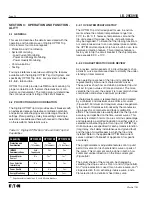
I.B. 29C891B
Page 32
Effective 11/98
torially sums the outputs of the individual phase current
sensors. As long as the vectorial sum is zero, no ground
fault exists.
If the system is 4-wire and a neutral conductor exists, it is
necessary to use an additional sensor for the purpose of
properly accounting for this neutral current in the ground
fault scheme. This sensor is mounted separately on the
neutral conductor at the point where the neutral conduc-
tor connects to the neutral bus. This sensor is usually the
same as the phase sensors internal to the circuit breaker.
The sensor does not have to be ordered separately since
it is included when an LSIA or LSIG version is ordered.
On R-Frame, SPB and DSII circuit breakers, zero
sequence ground current measurement is alternatively
available.
Ground Fault Alarm
A programmable ground fault alarm alerts a user of a
ground fault condition without tripping the circuit break-
er. In addition to being programmable, the ground fault
alarm can be enabled or disabled. A red Ground Fault
Alarm LED on the front of the trip unit will indicate the
presence of a ground fault condition that exceeds the
programmed setting (Figure
3-14
).
The ground fault alarm contact is energized when the
ground current exceeds the ground fault pickup setting
continuously for a time in excess of the ground fault
delay setting. Refer to Tables
3.2
and
3.3
for program-
mable values.
Ground Fault Pickup
The ground fault pickup establishes the current level at
which the trip unit’s ground fault function begins timing.
The pickup settings are the same for both ground fault
trip (LSIG) units and ground fault alarm (LSIA) units.
These settings are programmable over a range of fac-
tors by circuit breaker type as follows:
• Series C K, L and N-Frame Circuit Breakers
- 0.2 to 1.0 times sensor rating (I
s
) in 0.01 increments
(not to exceed 1200A)
• Series C R-Frame Circuit Breakers
- 0.24 to 1.0 times rating plug (I
n
) in 0.01 increments
(not to exceed 1200A)
• SPB Pow-R and DSII/DSLII Circuit Breakers
- 0.24 to 1.0 times rating plug (I
n
) in 0.01 increments
(not to exceed 1200A)
Figure
3-15
graphically illustrates how the ground fault
pickup portion of the overall curve can be moved horizon-
tally by means of the programmed settings.
Ground Fault Time Delay (I
2
t or Flat Slopes)
The ground fault time delay setting is programmable
with an I
2
t or a Flat slope for all ground fault type OPTIM
Trip Units as follows:
•
0.1 to 0.5 seconds in 0.01 increments at 0.62 times
rating plug (I
n
)
(for I
2
t slope)
•
0.1 to 0.5 seconds in 0.01 increments
(for Flat slope)
Figures
3-16
and
3-17
graphically illustrate how the
ground fault delay portion of the overall curve can be
moved vertically by means of the programmed settings.
Zone Selective Interlocking (Models 750 and 1050)
Zone selective interlocking is provided for the short
delay time and the ground fault delay tripping functions
for improved system coordination. Refer to paragraph 3-
2.5 under “Zone Selective Interlocking” and Figure
3-12
for additional details.
Ground Fault Memory
Ground faults may be sporadic in nature. As such, damag-
ing ground faults can occur and then subside in less time
than the programmed time for tripping the circuit breaker.
Should this type of cyclical ground fault condition persist,
the cumulative effect could result in equipment damage.
Figure 3-14 Ground Fault Alarm LED
Summary of Contents for Digitrip OPTIM 1050
Page 7: ......






























